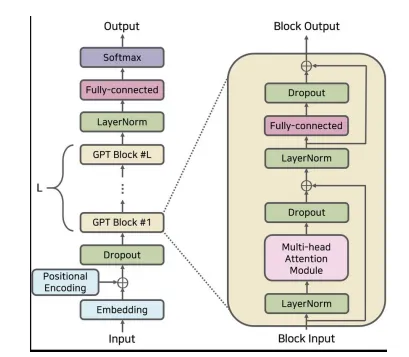291 words
1 minutes
[CS5242] GPT
Generative Pre-Trained Transformers
GPT-1
- Semi-supervised learning: combine unsupervised pre-training and supervised fine-tuning for language model
- no need to change model architecture for different tasks
Why do we use unsupervised training?
A: lack of labeled data to train language model
But difficult.
- unclear what type of optimization objectives
- no efficient way to transfer learned representations during fine-tuning
Goal: to learn an universal representation
Architecture: Transformer Decoder

- Transformer: enable more structure memory for handling long-term dependencies in text
- Decoder: decoder model using next token prediction training objective, more suitable for text generation
Stage 1: Unsupervised Pre-Training
- Given an unsupervised dataset of tokens
- use a standard language modeling objective to maximize likelihood
- i.e predict word using to words
Stage 2: Supervised Fine-tuning
- Given a labeled data pair with input sequence and a label
- Maximize and
- Pretraining data: BooksCorpus dataset, 7000 unpublished book
- 1B tokens
- 12 layers decoder-only transformer
- 12 attention heads
Comparison with BERT
- GPT: Decoder-only Transformer, uses next-token prediction
- BERT: Encoder-only Transformer, uses masked-language modeling
- GPT-1 lost the competition against BERT

It takes time for innovation to be recognized
GPT-2
- larger dataset & larger model
- WebText, 10B tokens, 1.5B parameters
- 10x GPT-1, 5x BERT large
- Zero-shot setting
- no more fine-tuning
- specify the task with natural language (prompt) and take it as input
- learn directly from natural language in the pretraining stage

GPT-3
- largest AI model by then
- 185B parameters, 1500x GPT-1, 100x GPT-2
- training dataset includes WebText, books, Wikipedia
- few-shot learning (in context learning)

- cannot guarantee zero-shot and one-shot are real
- may be just remembering examples in the training data
- we assume no similar pattern in learned in the training data
- cannot guarantee zero-shot and one-shot are real
Architecture

- Limitations:
- still has notable weakness in document-level text generation
- pretraining objective weights every token equally and lacks a notion of what is more important to predict
- power consuming